Opening the Possibility of the Commercialization of the Traditional Market
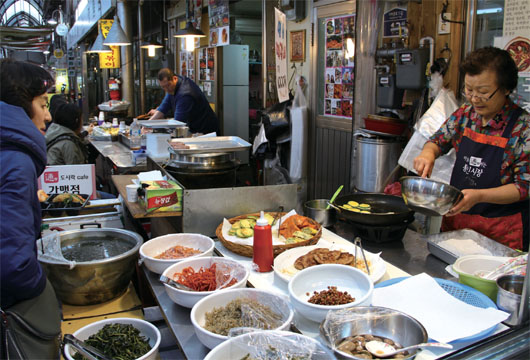
I visited the Tong-in market which is confronting hyper supermarkets and SSMs (Super Super Market) with a cultural heritage of “together means everything” as a weapon. Tong-in market is officially nominated as “the most modernized form of traditional market in Seoul.” This modernization is mostly motivated by the city. Jong-no gu published the first issue of “Tong-in Market Communication” on April 5, 2011. Seoul City has also done various projects decorating stores in combination with college students of Fine Arts.
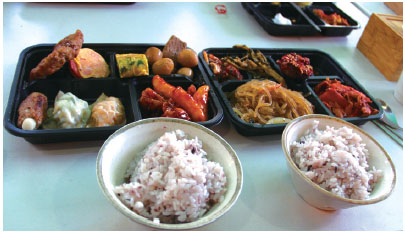
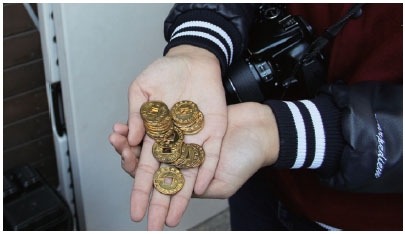
Lunch Cafe
The Tong-in market is crowded with people on the weekends, mainly because of local enterprises called “Lunch Cafe.” They follow a self revenuegenerating model which is possible, because the storekeepers have gathered their efforts together to make this “Lunch Cafe” work. Customers can buy empty lunch boxes with coupons, which are shaped like yeopjeon (the Korean currency during the Joseon Dynasty). They can fill up their lunch boxes using coupons while going around dish shops, bunsikjeom (stores that sell Korean food like odeng, sundae, tteokbokki, etc.) and rice cake shops. In addition, people can enjoy Korean buffet at a cheap price. Ten coupons are enough for one person to have lunch. Coupons are sold for 500 won each.
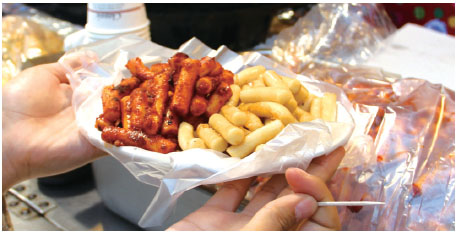
There is oil pasta in western food but what about “oil tteokbokki?” I wondered what it would taste like. Before the visit, I read a newspaper article’s evaluation on it. In the article, Kim (a Korean celebrity chef in U.S.) said that oil tteokbokki in Tong-in market is the best. He also said that his restaurant in Manhattan, New York has the very same tteokbokki and the restaurant received a “star” point from the Michelin guide, a bible of gourmets. The tteokbokki was without broth. Its texture was chewy rather than soft. Because the pepper powder were stuck to the tteokbokki, it looked spicy, but it was pleasantly refreshing. However, my expectations of Tong-in market’s tteokbokki were too high, so ultimately I was disappointed. It was too simple; the tteok (rice cake), gochujang (a paste made with chili peppers), and oil were the only ingredients. Also, the taste of oil was too strong.

has an interior like a neat cafe, and is located on the edge of Tong-in market’s alley. Uncommon these days, the restaurant does not represent stimulating but well-being food. They use 100 percent natural flavorings. The various side dishes are all vegan and are self-served. I felt like I was in some kind of buffet full of Korean traditional food. I would say it was a feast. I was surprised that there were “ginseng roast pork” and even alcohol on the menu. This is because normally temple food does not include these. I asked the owner about this, and she concluded that the Gwaggane restaurant got its motivation from temple food but does not offer only temple food. She told that she had once lived in a temple to cure a disease through meditation. There, by chance, she had the opportunity to learn how to make temple food from a monk. Eventually, she recovered by eating food made of nuts, one of the recipes she learned to cook from the temple. After that, she did more research on dishes that use nuts for ingredients and decided to open a restaurant.
At the restaurant, I ordered “mushroom added nut pot” and “ginseng roast pork.” After I tried one bite of the nut pot, I felt healthier. The harmony of the mushrooms and thick, stale broth was great. My first impression of the dish was like this; “How delicious can it be? It will be greasy.” Surprisingly, it had a clean and light taste when I ate the soup with rice. I think everyone can enjoy “ginseng roast pork” because it is not spicy. It really goes well with the nut pot.
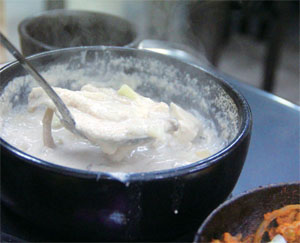
Traditional markets are not just places for consumption, but also the places that keep the history and culture of the region alive. Related agencies, government departments and residents should all value traditional markets.
They now have raised in popularity that 100 to 150 people visiting Tong-in market on a daily average, and almost 500 people visit on weekends. By forming local businesses such as the “Lunch Cafe,” they have used various resources and earned profits. It was also designated as “the most modernized traditional market” by the city.
However, the changes for the Tong-in market are just the beginning, because after the government’s business support programs are over, merchants will have to find ways to survive by themselves. They have a lot of work left to do.
All photos by Yoon Hee
Yoon Hee Junior Reporter
yoonhee1017@uos.ac.kr

